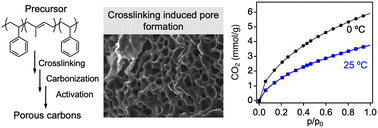CO2 capture from industrial point source waste streams represents an important need for achieving the global goal of carbon-neutrality. Compared with conventional liquid sorbents, solid sorbents can exhibit several distinct advantages, including enhanced lifetime and reduced energy consumption for sorbent regeneration. Considering that reducing CO2 emission is a great challenge, reaching approximately 37 billion metric tons just in 2021, ideal sorbent solutions should not only exhibit a high capture performance but also enable large scale manufacturing using low-cost precursors and simple processes. In this work, we demonstrate the use of a commodity polymer, polystyrene-block-polyisoprene-block-polystyrene (SIS), as the starting material for preparing hierarchically porous, sulfur-doped carbons for CO2 capture. Particularly, the sulfonation-crosslinking reaction enables the formation of macropores in the polymer framework due to the release of gaseous byproducts. After carbonization and activation, the highly porous structure of SIS-derived carbons is successfully retained, while their surface area can reach up to 905 m2 g−1. These porous carbon sorbents exhibit excellent CO2 uptake performance, reaching sorption capacities of 3.8 mmol g−1 at 25 °C and 6.0 mmol g−1 at 0 °C, as well as a high selectivity up to 43 : 1 against N2 gas under ambient conditions. Overall, our work provides an industrially viable method for “template-free” fabrication of porous carbons from commodity polyolefin-based materials, which can be employed for reducing CO2 emission from industrial plants/sectors.

